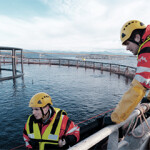Santa Monica Seafood to make acquisitions this year after sales uptick

Santa Monica Seafood suffered tremendous losses at the start of the COVID-19 pandemic – similar to other distributors and processors that primarily relied on the foodservice channel. But the tide has turned in the past year, according to Santa Monica Seafood President and CEO Roger O’Brien.
Due to restaurant closures beginning last March, the Rancho Dominguez, California, U.S.A.-based company saw some of its foodservice customers unable to pay its bills. Others shifted from 30-day payments to paying 60 days out from delivery. Santa Monica was forced to lay off around 25 workers, but kept on more than 750 employees, according to O'Brien.
Despite the setbacks, O’Brien is confident about his company's future. So much so that he told SeafoodSource he believes 2021 will be a “record-setting” year for the distributor, which also operates two seafood markets and cafés in California.
Additionally, plans for Santa Monica to acquire seafood companies are in the works, he said. While no definitive purchase agreements are signed, “we are pursuing a number of acquisition opportunities,” O’Brien told SeafoodSource, likely allowing the company to expand its geographic presence.
“Some of these relationships developed during the pandemic, during which time both we and the target companies got to know each other while we anxiously awaited the pandemic to start turning around,” O’Brien said.
O’Brien is optimistic that SMS will close one transaction before the end of the second quarter, and another by the end of this year.
O'Brien is projecting revenue growth of around 21 percent compared to 2020, and a 50 percent spike in earnings before interest, taxes, depreciation, and amortization (EBITDA) compared to 2020.
“Both 2021 metrics will be improvements over 2019 as well,” O’Brien said. “Financial results for the past three months have us operating at better than pre-pandemic levels and well in line with our 2021 projections.”
The revenue hike can be attributed to both retail and foodservice business increasing, and strong sales in its skin-pack division, O'Brien said. Last December, SMS bought out the equity interest in a joint venture controlling Ethos Seafood Group, a manufacturer of pre-packaged, chilled seafood products sold at retail outlets across the country.
Ethos Seafood, founded in 2012 as a joint venture between Santa Monica Seafood and Blue Earth Group, is now 100-percent owned by Santa Monica Seafood and is considered a division of the company. The Ethos Seafood name has been phased out as the group becomes Santa Monica Seafood’s value-added products division.
Revenue in that division soared 45 percent in 2020 and was up 32 percent in the first quarter of 2021 year-on-year.
At the start of the pandemic, when around 60 percent of its revenue was in foodservice sales, Santa Monica turned to servicing retail customers with skin-pack seafood and other products.
This year, its foodservice sales have returned somewhat due to loosening government restaurant restrictions, but remain at 63 percent of pre-pandemic levels.
"The big drag on foodservice business is the hospitality, institutional, and convention business that has been extremely slow to rebound,” O’Brien said.
Last year, Santa Monica added "Dock Direct,“ a direct-to-consumer e-commerce program, and saw strong sales through it in December and in Q1 2021, according to O'Brien.
“However, we noticed a definite slowdown in April as indoor restaurant dining began reopening. As many of our retail customers have experienced, our e-commerce B2C has also experienced a recent slow-down as consumers have been flooding restaurants with their pent-up demand to have a nice meal at one of their favorite, recently reopened restaurants,” O’Brien said.
Santa Monica faces several other challenges this year, according to O'Brien, including labor shortages, seafood price increases, and transportation price hikes. The company has 63 job openings this month, compared to 22 at the beginning of January, due to an increase in business.
“We are having the most difficulty recruiting entry-level packers, cutters, and other manual laborers,” O’Brien said.
Plus, ocean freight costs have spiked to “astronomical levels – some are now 300 to 400 percent higher than they were pre-pandemic,” O’Brien said.
“This all goes to show the U.S. reliance on imported seafood. As U.S. demand for imports increase while U.S. export volumes plummet, cost inefficiencies quickly multiply,” O’Brien said. “Throughout this pandemic, U.S. export volumes were heavily impacted and as a result, round-trip values of ocean freight containers dramatically increased.”
Photo courtesy of Santa Monica Seafood






Share